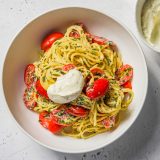Cacio e pepe and a foul temper. When you ask about Felice Trivelloni, you never hear about just one; they are inseparably synonymous with the Roman restaurateur. His take on this classic pasta was as epic as his tendency to gruffness.
It’s something his grandson, Franco Ines, chuckles about. Felice, after all, translates as “happy.” Now, Ines runs the family restaurant, Felice a Testaccio, a boisterously popular eatery tucked on a corner of Rome’s once rough-and-tumble Testaccio neighborhood.
Which might explain Trivelloni’s surly side; he often sent away would-be diners, even regulars and those with reservations. As family lore tells it, Trivelloni had a soft spot for his hardscrabble neighbors and kept seats open at the restaurant just in case they needed a meal.
Today, the vibe—in and outside the eatery—is a bit more refined. Trivelloni, who started the restaurant in 1936 after selling wine from a cart as a teenager, worked both the kitchen and dining room for 73 years.
Luckily, his recipes remain. Today, they are prepared by chef Emiliana Rossetti, who learned them from Trivelloni. The menu is an ode to Roman classics, including saltimbocca alla Romana. But really the focus is the pastas. As it should be.
There is carbonara, of course. And its cousins, gricia and all’Amatriciana. The rightful star is the cacio e pepe, a famously rich swirl of tonnarelli pasta coated with both pecorino Romano and Parmesan cheeses, as well as ample black pepper.
It deserves its reputation, striking a beautiful balance of creamy and rich with peppery and bright. But that fame risks overshadowing an equally delicious offering, a not-quite-natively Roman creation by Trivelloni himself.
The simply named spaghetti alla Felice marries perfectly al dente pasta to an entirely uncooked sauce of ricotta cheese, tomatoes and tons of herbs. The result is fresh and creamy with just hints of sweetness and acidity from the tomatoes.
And the process could not be simpler. Rossetti began by lightly crushing cherry tomatoes, then combining them with a riot of chopped herbs—basil, mint, oregano, thyme and marjoram—a bit of ricotta cheese and a sprinkle of salt.
When the pasta was ready, she tossed it repeatedly with the sauce, the heat of the spaghetti lightly warming it, drawing the flavors together. That was the extent of the cooking.
The taste was simple and summery. And it made me glad I didn’t need to joust with Trivelloni’s sour side to get a taste.








